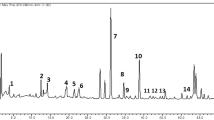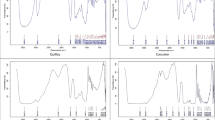Abstract
Five honey types produced in Croatia (black locust, lime, sage, chestnut and honeydew) were characterised from the aspect of antioxidant capacity in order to evaluate possible application of antioxidant capacity as a criterion for botanical origin identification. Towards better understanding honey antioxidant capacity, relationship between antioxidant capacity and quality parameters (moisture, electrical conductivity, HMF content, colour, phenolic content) was evaluated using correlation coefficients and principal component analysis (PCA). Antioxidant capacity of analysed honey types varied significantly depending on the botanical origin. Highest antioxidant capacity was determined in dark honeydew and chestnut honey, followed by lime and sage honey, while the lightest black locust honey had the lowest antioxidant capacity. Among evaluated parameters, antioxidant capacity showed highest correlation with phenolic content and colour, with correlation coefficients above 0.89 (p < 0.05). PCA showed that different honey types can be differentiated based on their antioxidant capacity and related parameters.

Similar content being viewed by others
References
Frankel S, Robinson GE, Berenbaum MR (1998) Antioxidant capacity and correlated characteristics of 14 unifloral honeys. J Apic Res 37(1):27–31
Gheldof N, Wang XH, Engeseth NJ (2002) Identification and quantification of antioxidant components of honey from various floral sources. J Agric Food Chem 50(21):5870–5877
Bertoncelj J, Doberšek U, Jamnik M, Golob T (2007) Evaluation of the phenolic content, antioxidant activity and colour of Slovenian honey. Food Chem 105(2):822–828
Pérez RA, Iglesias MT, Pueyo E, González M, de Lorenzo C (2007) Amino acid composition and antioxidant capacity of Spanish honeys. J Agric Food Chem 55(2):360–365
Alvarez-Suarez JM, Tulipani S, Díaz D, Estevez Y, Romandini S, Giampieri F, Damiani E, Astolfi P, Bompadre S, Battino M (2010) Antioxidant and antimicrobial capacity of several monofloral Cuban honeys and their correlation with color, polyphenol content and other chemical compounds. Food Chem Toxicol 48:2490–2499
Brudzynski K, Miotto D (2011) Honey melanoidins: analysis of the compositions of the high molecular weight melanoidins exhibiting radical-scavenging activity. Food Chem 127:1023–1030
Brudzynski K, Miotto D (2011) The relationship between the content of Maillard reaction-like products and bioactivity of Canadian honeys. Food Chem 124:869–874
Brudzynski K, Miotto D (2011) The recognition of high molecular weight melanoidins as the main components responsible for radical-scavenging capacity of unheated and heat-treated Canadian honeys. Food Chem 125:570–575
Huang D, Ou B, Prior RL (2005) The chemistry behind antioxidant capacity assays. J Agric Food Chem 53:1841–1856
Prior RL, Wu X, Schaich K (2005) Standardised methods for the determination of antioxidant capacity and phenolics in foods and dietary supplements. J Agric Food Chem 53(10):4290–4302
Beretta G, Granata P, Ferrero M, Orioli M, Facino RM (2005) Standardization of antioxidant properties of honey by a combination of spectrophotometric/fluorimetric assays and chemometrics. Anal Chim Acta 533:185–191
Sant’Ana LDO, Sousa JPLM, Salgueiro FB, Lorenzon MCA, Castro RN (2012) Characterisation of monofloral honeys with multivariate analysis of their chemical profile and antioxidant activity. J Food Sci 71(1):C135–C140
Sant’Ana LDO, Ferreira ABB, Lorenzon MCA, Berbara RLL, Castro RN (2014) Correlation of total phenolic and flavonoid contents of Brazilian honeys with colour and antioxidant capacity. Int J Food Prop 17:65–76
Ministry of Agriculture, Fisheries and Rural Development (2009) Regulation on the quality of unifloral honey. Off Gaz 122:15–16
Ministry of Agriculture, Fisheries and Rural Development (2009) Regulation on the quality of honey. Off Gaz 93:7–8
Codex Alimentarius Commission (2001) Revised codex standard for honey. Alinorm 01(25):19–26
Council of the European Union (2002) Council directive 2001/110/EC of Dec 20, 2001, relating to honey. Off J Eur Commun L10:47–52
Louveaux J, Maurizio A, Vorwohl G (1978) Methods of melissopalynology. Bee World 59:139–157
Bogdanov S, Martin P, Lüllmann C (1997) Harmonised methods of the European honey commission. Apidologie (extra issue) 28:1–59
White JW (2000) In: Graham JM (ed) The hive and the honey bee. Dadant & Sons, Hamilton, pp 869–925
Association of Official Analytical Chemists International (AOAC) (2000) Official methods of analysis, 17th edn. Gaithersburg, MD, USA, p 22
Brand-Williams W, Cuvelier ME, Berset C (1995) Use of a free radical method to evaluate antioxidant activity. Lebensm Wiss Technol 28:25–30
Benzie IFF, Strain JJ (1996) The ferric reducing ability of plasma (FRAP) as a measure of “antioxidant power”: the FRAP assay. Anal Biochem 239(1):70–76
Bogdanov S, Rouff K, Persano Oddo L (2004) Physico-chemical methods for the characterisation of unifloral honeys: a review. Apidologie 35:S4–S17
Persano Oddo L, Piro R (2004) Main European unifloral honeys: descriptive sheets. Apidologie 35:S38–S81
Kenjerić D, Primorac LJ, Mandić ML, Bubalo D, Perl Pirički A, Flanjak I (2006) Dalmatian sage (Salvia officinalis L.) honey characterisation. Dtsch Lebensmitt Rundsch 102(10):479–484
Kropf U, Jamnik M, Bertoncelj J, Golob T (2008) Linear regression model of the ash mass fraction and electrical conductivity for Slovenian honey. Food Technol Biotech 46(3):335–340
Primorac LJ, Flanjak I, Cvijetić M, Đapić Z (2011) Electrical conductivity and ash content of selected honey types. In: Šubarić D (ed) International Scientific and professional conference 13th Ruzicka days “today science-tomorrow industry” proceedings, Osijek, pp 406–411
Lazarević KB, Andrić F, Trifković J, Tešić Ž, Milojković-Opsenica D (2012) Characterisation of Serbian unifloral honeys according to their physicochemical parameters. Food Chem 132:2060–2064
United States Department of Agriculture (1985) United States standards for grades of extracted honey. http://www.ams.usda.gov/AMSv1.0/getfile?dDocName=STELDEV3011895. Accessed 24 June 2011
Devillers J, Morlot M, Pham-Delégue MH, Doré JC (2004) Classification of monofloral honeys based on their quality control data. Food Chem 86:305–312
Al ML, Daniel D, Moise A, Bobis O, Laslo L, Bogdanov S (2009) Physico-chemical and bioactive properties of different floral origin honeys from Romania. Food Chem 112:863–867
González-Miret ML, Terrab A, Hernanz D, Fernández-Recamales MA, Heredia FJ (2005) Multivariate correlation between color and mineral composition of honeys and by their botanical origin. J Agric Food Chem 53:2574–2580
Mateo Castro R, Jiménez Escamilla M, Bosch Reig M (1992) Evaluation of the color of some Spanish unifloral honey types as a characterization parameter. J AOAC Int 75(3):537–542
Terrab A, Gonzalez AG, Diez MJ, Heredia FJ (2003) Characterisation of Moroccan unifloral honeys using multivariate analysis. Eur Food Res Technol 218:88–95
Krpan M, Marković D, Šarić G, Skoko B, Hruškar M, Vahčić N (2009) Antioxidant activities and total phenolics of acacia honey. Czech J Food Sci 27:S245–S247
Gheldof N, Engeseth NJ (2002) Antioxidant capacity of honeys from various floral sources based on the determination of oxygen radical absorbance capacity and inhibition of in vitro lipoprotein oxidation in human serum samples. J Agric Food Chem 50(10):3050–3055
Lachman J, Orsák M, Hejtmánková A, Kovářová E (2010) Evaluation of antioxidant activity and total phenolics of selected Czech honeys. LWT Food Sci Technol 43:52–58
Piljac-Žegarac J, Stipčević T, Belščak A (2009) Antioxidant properties and phenolic content of different floral origin honeys. J Apiprod Apimed Sci 1(2):43–50
Jerković I, Marijanović Z (2010) Oak (Quercus frainetto Ten.) honeydew honey-approach to screening of volatile organic composition and antioxidant capacity (DPPH and FRAP assay). Molecules 15:3744–3756
Tuberoso CIG, Jerković I, Bifulco E, Marijanović Z, Congiu F, Bubalo D (2012) Riboflavin and lumichrome in Dalmatian sage honey and other unifloral honeys determined by LC–DAD technique. Food Chem 135:1985–1990
Acknowledgments
The authors would like to express their gratitude to Prof Milena Mandić, for scientific advisements and support in all stages of this study.
Author information
Authors and Affiliations
Corresponding author
Ethics declarations
Conflict of interest
The authors declare that they have no conflict of interest.
Human and animal rights
This article does not contain any studies with human or animal subjects.
Rights and permissions
About this article
Cite this article
Flanjak, I., Kenjerić, D., Bubalo, D. et al. Characterisation of selected Croatian honey types based on the combination of antioxidant capacity, quality parameters, and chemometrics. Eur Food Res Technol 242, 467–475 (2016). https://doi.org/10.1007/s00217-015-2557-0
Received:
Revised:
Accepted:
Published:
Issue Date:
DOI: https://doi.org/10.1007/s00217-015-2557-0




